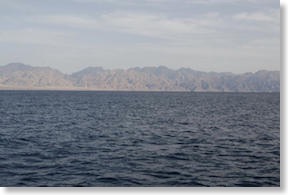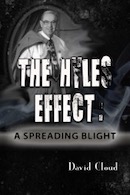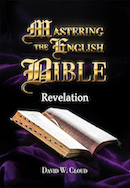866-295-4143, fbns@wayoflife.org

(1) The Hebrew word “suph,” which is translated “Red” in most Bibles, does mean “reed,” but this does not mean that the Bible is talking about a shallow reed lake. The Red Sea was called “Reed Sea” in ancient times, not because it was shallow, but because reeds grow in marshy areas along its shores in places. (The Hebrew word refers to water reeds in general and not to papyrus only.) Further, in the New Testament it is called the Red Sea and not the Reed Sea (Acts 7:36; Heb. 11:29). In ancient times the name Red Sea was given to the entire Arabian Sea, including the modern Red Sea and its arms and the Persian Gulf (Kenneth Kitchen, On the Reliability of the Old Testament). In 1 Kings 9:26, the Gulf of Aqaba where Ezion Geber was located is called the Red Sea.
(2) The bottom line is that the Bible says they crossed a sea, and the description of the crossing is not the description of a marsh or a lake. In ancient times the Bitter lakes were not deep; they were more like marshy salt flats.* But the water that Israel crossed is described as deep and mighty. It formed a wall unto the Israelites on the right and left as they crossed it (Ex. 14:22; 15:4-5, 10; Neh. 9:11; Psa 106:9; Isa. 51:10). Paul describes the crossing as a baptism in the cloud and in the sea (1 Cor. 10:1-2). Baptism means immersion, so Paul was saying that Israel walked between towering walls of water beneath the cloud of glory. We know, then, that the crossing was over an arm of the sea itself and not a lake or marsh. (* “Prior to the opening of the Suez Canal in 1869, Great Bitter Lake was a large salt flat; in the arid climate, basins rarely accumulate enough water to become true lakes,” NASA Earth Observatory).
WHERE DID ISRAEL CROSS THE SEA?
Traditionally, the crossing was somewhere in the north of the Gulf of Suez. According to this view, Israel crossed here and then journeyed south into the peninsula to Mt. Sinai. The exact mountain is not known with certainty, though there are two or three good candidates, including Gebel Musa where St. Catherine’s Monastery is located.
A modern view that was proposed by Charles Beke in 1834 and has been popularized since the 1980s by Ron Wyatt, Larry Williams, Bob Cornuke, Howard Blum, and others is that Israel crossed the Red Sea where it enters the Gulf of Aqaba (the Straits of Tiran) and that Mt. Sinai is Mt. Jabel Al-Lawz in the Arabian Peninsula. This view is based on the idea that the traditional location doesn’t seem to fit with some of the Bible’s statements about the location of Mt. Sinai. According to the early chapters of Exodus, Mt. Sinai (also called Horeb, De. 4:15) was where Moses tended the sheep of Jethro, and since Jethro was a priest of Midian this is thought to have been the traditional land of Midian east of the Red Sea (Ex. 2:15: 3:1, 12). Further, Paul said that Sinai is in Arabia (Gal. 4:25), and the Arabian Peninsula is to the east of the Red Sea’s Gulf of Aqaba.
There are problems with both the traditional and the new view, but having looked at both I believe for the following reasons, among others, that the traditional Bible maps are generally correct.
(1) Israel calls the peninsula between the gulfs (Suez and Aqaba) the Sinai Peninsula, and I believe that she knows her own history.
(2) When Paul said that Sinai is in Arabia, this does not mean that he was referring to Saudi Arabia of modern times. Graham Davies says that in Paul’s time Arabia covered a wide area that “included the Sinai Peninsula” (Davies, Wilderness, 1979, pp. 30, 99 n. 1). He sites the Greek historian Herodotus in the 5th century BC who said that the Sinai Peninsula was considered part of Arabia. In his 1834 Hebrew lexicon, Wilhelm Gesenius listed Sinai as part of Arabia.
(3) The Bible doesn’t say that Moses was in the traditional Midian territory when he saw the burning bush and met with God. It simply says that he led the flock to the backside of the desert. It could be that Moses father-in-law didn’t live in the Midian territory east of the Red Sea. The Midianites were nomadic, and several ancient and modern scholars have stated that Midianites also lived in the northern part of the Sinai Peninsula. (Brad Sparks in “Problems with Mt. Sinai in Saudi Arabia” cites William F. Albright, H. H. Rowley, G. Ernest Wright, Roland de Vaux, Avraham Negev, http://ldolphin.org/sinai.html.) If Moses lived somewhere in the northern Sinai Peninsula with Jethro, it would not have been unreasonable for him to have traveled farther south in search of grazing.
(4) The Sinai in Saudi Arabia view is refuted by the biblical statement that Moses’ father-in-law left Mt. Sinai to go to his own country (Ex. 18:27) and the statement that Moses’ nephew returned from Mt Sinai to his own land (Num. 10:29-31). Thus Mt. Sinai was located in a separate place from where Jethro lived.
(5) The Sinai in Saudi Arabia view is refuted by the statement in Exodus 15:22 that after Israel crossed the sea Moses led them to Shur. Genesis 25:18 says Shur was “before Egypt,” and 1 Samuel 15:7 says it was “over against Egypt.” Shur is the way that Hagar traveled when she was fleeing from Sarah in Hebron back to her home in Egypt (Gen. 16:6-7).
(6) Ron Wyatt (1933-1999) was a Seventh-Day Adventist and his alleged discovery of such things as ancient Egyptian chariot wheels, bones of Egyptian horses and soldiers, fences from Noah’s farm, the tables of the Ten Commandments, and a sampling of Christ’s blood has been debunked. See Russell and Colin Standish, Holy Relics or Revelation: Recent Astounding Archaeological Claims Evaluated. A summary of the evidence is discussed by Wayne Jackson, “Ron Wyatt, ‘The Indiana Jones’ of the SDA Church,” The Christian Courier, www.christiancourier.com. Wyatt was a deluded man who claimed to have seen Jesus dressed exactly like the SDA prophetess Ellen White described Him.
- Receive these reports by email
- www.wayoflife.org
______________________
Sharing Policy: Much of our material is available for free, such as the hundreds of articles at the Way of Life web site. Other items we sell to help fund our expensive literature and foreign church planting ministries. Way of Life's content falls into two categories: sharable and non-sharable. Things that we encourage you to share include the audio sermons, O Timothy magazine, FBIS articles, and the free eVideos and free eBooks. You are welcome to make copies of these at your own expense and share them with friends and family. You may also post parts of reports and/or entire reports to websites, blogs, etc as long as you give proper credit (citation). A link to the original report is very much appreciated as the reports are frequently updated and/or expanded. Things we do not want copied and distributed are "Store" items like the Fundamental Baptist Digital Library, print editions of our books, electronic editions of the books that we sell, the videos that we sell, etc. The items have taken years to produce at enormous expense in time and money, and we use the income from sales to help fund the ministry. We trust that your Christian honesty will preserve the integrity of this policy. "For the scripture saith, Thou shalt not muzzle the ox that treadeth out the corn. And, The labourer is worthy of his reward" (1 Timothy 5:18). Questions? support@wayoflife.org
Goal:Distributed by Way of Life Literature Inc., the Fundamental Baptist Information Service is an e-mail posting for Bible-believing Christians. Established in 1974, Way of Life Literature is a fundamental Baptist preaching and publishing ministry based in Bethel Baptist Church, London, Ontario, of which Wilbert Unger is the founding Pastor. Brother Cloud lives in South Asia where he has been a church planting missionary since 1979. Our primary goal with the FBIS is to provide material to assist preachers in the edification and protection of the churches.
Offering: Offerings are welcome if you care to make one. If you have been helped and/or blessed by our material offerings can be mailed or made online with with Visa, Mastercard, Discover, or Paypal. For information see: www.wayoflife.org/about/makeanoffering.html.





